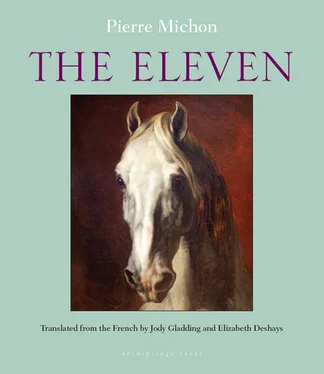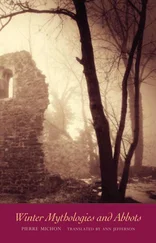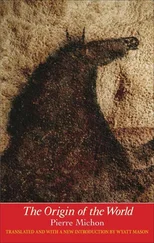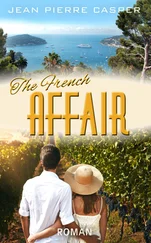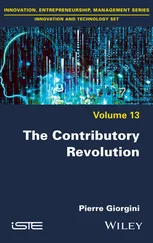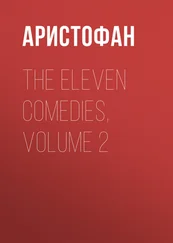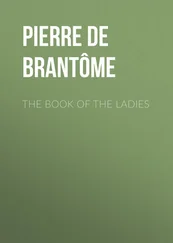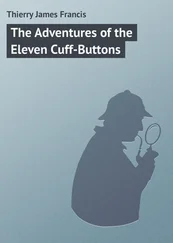And certainly Michelet, in that first shock caused by the painting (he had thought he would faint, he writes, and we can well believe it), immediately had the revelation from which he would later draw the famous exegesis that is contained in twelve pages. There he saw a secular last supper, perhaps the first secular last supper, he notes, the one in which bread and wine are still resolutely sacrificed but in the absence of Christ, despite that absence, above and beyond that absence, man having become stronger than that absence; he saw and saw clearly that it was a true last supper, that is, in eleven individual men a collective soul, not just a collection of men. And in that he is not wrong; at most one can object that if God is a dog, the absence of God is a bitch. And since it was a last supper, there must certainly have been a table, and on it the four-pound loaves and Clamart wine; so he extrapolated them, the table, the bread, and the wine. It did not bother him that the eleven men were standing, and not dreamily seated as in classic scenes of the last supper; on the contrary he writes that his republican last supper renews the tradition of the original evangelical meal that was to be taken standing, staff in hand, loins girded , girded for marching, or girded à la nation , ready for action. And the presence of Collot in the painting, playing both sides, did not bother him either; on the contrary, it confirmed his view, because among the guests at this type of meal, it is hard to do without Judas even if we can do without Christ, as The Eleven proves.
Of course, but this is another story, Michelet detested this painting as much as he admired it, because it is a last supper that is rigged, not by the absence of Christ, which he cared little about and which even pleased him — no, rigged because the collective soul visible there is not the People , the ineffable soul of 1789, it is the return of the universal tyrant who presents himself as the people. Not eleven apostles, eleven popes.
No matter. In the great wind of light that so shook Michelet at the Louvre in 1820, the pale and trembling young man, his hair still black though not for long, there is also this: Michelet, who always said and thought that the true painting of History was only true when it did not try to represent History, Michelet found himself refuted here. And he acknowledged it openly. The Eleven is not a painting of History, it is History. Perhaps what Michelet saw at the end of the Flore pavilion was History in person, in eleven persons — in terror, because History is pure terror. And that terror attracts us like a magnet. Because we are men, Sir; and because men high and low, scholars and beggars, passionately love History, that is, the terrors and the massacres; they hasten from afar to contemplate them, the terrors and the massacres, under pretext of deploring them, even of rectifying them, so they claim, the good creatures — and that is why we are here, Sir, with the crowds from all over the world before the ever enigmatic wall of eleven men upon which History is perched. That is why the crowds from all over the world shoot past the Mona Lisa without seeing it, since it is only a woman dreaming, past Uccello’s Battle of San Romano although it is, in its way, History in person and one of the indubitable precedents for The Eleven , past the red specter of the cardinal-duke painted by Champaigne, past thirty-six times Louis the Great under his monster wig, and plant themselves here, before the bulletproof glass.
Michelet, as he noted, understood here at age eighteen why David’s Death of Marat is only a small Caravaggesque canvas, inconsequential, exiled to the peripheral museum at Versailles, while the great Venetian canvas, The Eleven , enthroned at the end of the Louvre, is the Louvre’s final raison d’être; its ultimate aim; he understood why the whole colossal arrow of the Louvre, the colonnade where you enter, the Cour Carré you cross like the wind, the Apollon gallery that you cover in three steps, the four hundred and forty-seven meters of the Bord-de-l’Eau gallery that you race through, why perhaps all that in the final analysis was only conceived by the Great Architect to carry us to the heart of that target into which the Louvre plunges straight as an arrow. He understood why David is in the purgatory of minor painters, those who are nothing but painters, while Corentin, haloed, sits enthroned at the zenith: because David’s Marat is only a dead man, a remnant of History, perhaps its corpse. And the eleven living men are History in action, at the height of the act of terror and of glory that is the basis of History — the real presence of History.
We are here before it.
See how they change when you move to the left. I can almost see the holy table, under Prieur’s resting hand. And is that the glass of wine in front of Couthon? No, it must be the red and blue plume of Prieur’s hat. But neither bells nor horses.
No, undoubtedly, no horses. And yet: see the eleven pale heads one after the other, aligned, detached, springing naked from the mass of silk, felt, woolen cloth; the eleven masks: — Billaud, pale and long, from the black clothes under the fiery mane, pale Carnot from the black greatcoat, the two Prieurs emerging from the fitted jackets à la nation , lower down, the sunken head of the seated Couthon borne by the double robe of sulfur and basalt, and higher up once again, the pale face of Robespierre offered in worn clothes blacker than black — and the mask named Collot suspended above his pyramid of inverted collars, and all the others likewise to Jean Bon springing from the redundant tricolored jacket. These perched forsaken heads make you think of something, something older and less conjectural than severed heads on the ends of pikes, as has too often been said. And again, if you do as I advise you and move back from the painting, if you resolutely turn away from it, if you carefully retrace your steps, if you leave the room and take a few steps into the Bord-de-l’Eau gallery, turn around once again, once again, deliberately, enter the great hall where to the exclusion of all other paintings The Eleven stands; then if you stop on the threshold and look at the eleven as if you were seeing them for the first time — then, yes, you almost know what they make you think of. And if moreover when you are not at the Louvre you happen to go riding, to practice for memory’s sake that very old and obsolete occupation of men, or if you simply happen to frequent places where riding horses stand in fearful repose; and if perhaps you remember a day when, coming from the other end of the field and approaching at your own pace the wide angle of the stable where the horses lined up in their stalls are facing you, but all you can see of them are their heads, cut off and accentuated by the small lower door that hides their bodies, so that they appear to be suspended above by virtue of the Holy Spirit, spectral, alive, fixed in the dread and the slow expectancy of beasts — then perhaps you think that Michelet is not altogether wrong in his dreaming and that there in the Louvre are eleven forms similar to horses, eleven creatures of terror and temper: as sculpted by the Assyrians of Nineveh in the royal equestrian lion hunts; as they gallop toward the damned that are us, seven times and under seven forms of horses, in the Apocalypse of Saint John; as rearing under Niccolò da Tolentino, the condottiere of the night in Uccello; as rearing too under the Philippes of France and the Louis of France as well, the thirty-two Capets, later under Bonaparte; as Géricault painted them in the uproar of artillery lines exploding one after another, terrified by the smell of powder and the smell of death, but charging as if unafraid. And since this is what it has come to, you and I are suddenly standing before any divine beast whatsoever, not only horses but all of them, horned beasts, barking beasts, other roaring beasts that turning around suddenly leap on the king in the Nineveh hunts, the great frontal threats that resemble us and are not us. The ones that were painted at the very beginning, before Assyria and Saint John, before the invention of carts and cavalry, well before Corentin and poor Géricault, in the times of the great hunts, in the times when game was worshipped and dreaded, divine and tyrannical, on the deep walls of caves.
Читать дальше
